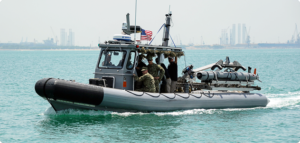HII [HII] on Monday unveiled its newest medium-class unmanned undersea vehicle (UUV), the REMUS 620.
The company underscored the new UUV is a second generation medium-class UUV with the same size and weight of the earlier REMUS 600, allowing for easier integration to current logistics. Both vessels are 12 and three quarter inches in diameter.
![Graphic model of the HII Mission Technologies' REMUS 620 medium-class unmanned undersea vehicle (UUV). (Image: HII]](https://www.defensedaily.com/wp-content/uploads/2022/11/hii-remus-620-scaled-e1667585913538-300x169.jpg)
This means it is also the same size and weight of the MK 18 Mod 2 Littoral Battleship Sensing-Autonomous Undersea Vehicle (LBS-AUV) and LBS-Razorback systems operated by the Navy’s Mine Countermeasure Squadrons, U.S. Naval Oceanographic Office and Submarine Forces, both based on the REMUS 600 design.
HII acquired former REMUS line UUV manufacturer Hydroid in March 2020.
The REMUS 620 has a battery life of up to 110 hours; a range of 275 nautical miles; and is designed to be deployed from submarines, small manned or unmanned boats, amphibious ships, surface combatants and helicopters. The company also boasted it can be a platform to launch and operate other unmanned vehicles or payloads and the REMUS 620s can operate collaboratively.
Duane Fotheringham, president of Mission Technologies’ Unmanned Systems business group at HII, told reporters in a press call ahead of the announcement this translates into either 110 hours with a 275 nautical mile range or 70 hours and over 200 nautical miles with a synthetic aperture payload, which is “more than a four time improvement over our standard REMUS 600.”
He added the 620 model can travel at up to eight knots “for spring capability and operation in a high current environment.”
Fotheringham argued the vehicle “is the first medium UUV designed to accurately deliver this range of advanced above-and-below water effects at long range.”
HII said the newest UUV also uses the same kind of open architecture and modular design philosophy as its REMUS 300 UUVs. It bills the REMUS 620 as capable of being used for mine countermeasures, hydrographic surveys, intelligence collection, surveillance and electronic warfare missions.
The Navy previously selected the REMUS 300 as the program of record for the Lionfish Small UUV.
HII underscored the REMUS 620 has a modular open architecture design that can support current and future naval operations. This will “facilitate seamless payload integration and HII’s Odyssey suite of advanced autonomy solutions for intelligent, robotic platforms,” and third-party autonomy options, the company said.

HII launched the Odyssey suite of autonomy solutions in April and billed it as able to help make any kind of vehicle a robotic system (Defense Daily, April 13).
Fotheringham said the vessels’ open architecture approach means it is designed to support the Navy’s unmanned maritime autonomy architecture (UMAA) and the U.K. MAPLE unmanned architecture.
He also noted HII “really tried to make the vehicle so it’s easy to integrate third party solutions, so almost any solution developed for torpedo tube recovery could be integrated into the REMUS 620 And being a medium class vehicle, it’s well within the size requirements of recovery back into the torpedo tube.”
The vessel can use a standard synthetic aperture sonar payload that can be enhanced or replaced for intelligence, surveillance and reconnaissance, and cyber and electronic warfare missions.
Fotheringham said REMUS 620 includes an externally accessible and removable hard drive and it was designed for ease of payload integration.
“Primary payloads can be dry payloads that are inserted inside the main pressure boundary or wet payloads that are inserted outside the main pressure boundary. We’ve also included two secondary payload interfaces that are accessed via a universal bulkhead adapter, allowing for tailored options. These are located in the rear of the vehicle, and they’re envisioned to support custom payloads, including towed payloads.”